|
|
INTEL
PROCESSOR-BASED BOARDS
810E Chipset-based Boards
The 820 chipset never took off and numerous delays led to quite
a problematic situation for Intel, as processors running at
133 MHz FSB were available but there were no chipsets using
standard SDRAM from Intel to support these processors. Coupled
with the growing popularity of the VIA Appolo Pro-based solutions
and Intel had some serious catching up to do. Therefore, to
solve the 133 MHz problem, Intel decided to launch the i810E,
which supported PC-133 RAM and was totally compatible with the
Coppermines working at 133 MHz. |
|
| |
|
ASUS
P3WE
A top-notch performer
The ASUS entry into this bracket makes up for the lack of
a motherboard for the power user. The ASUS P3WE stands apart
in the 810E range of motherboards simply due to the fact that
it gives the users an enormous edge when it comes to upgrading.
The board layout is in typical ASUS fashion with rows of capacitors
arranged in a unobtrusive fashion. Using six 1500uf capacitors
near the CPU Slot 1 interface gives a sure hint that the motherboard
has been built with the overclocker in mind. The board also
uses the high-quality 7ns 4 MB SDRAM display cache. The box
contains a very detailed user manual along with a bag of spare
jumpers that has now become a common feature with all ASUS
boards. Also the Slot 1 interface had an excellent CPU retention
mechanism. The only gripe was that the board did not have
a Socket 370 interface for the CPU. But we received the revision
1.04 of the board and using the BIOS version 1004 or later
the board supported all varieties of the Intel Coppermine
family. Using a Socket 370 adapter that supported the lower
voltages used by the newer Coppermines is a must though.
The BIOS features a multitude of FSB, voltage, I/O tweaks
and settings. The board overclocked well and despite being
based on the rather slow side, this 810E chipset is a top-notch
performer.
Contact:
Mnemonic Systems
Phone: 022-8010871
Price: Rs 7,800
Rating: A
|
|
| |
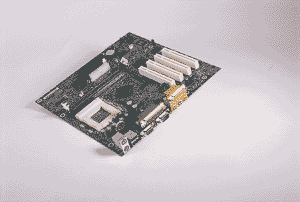 |
Intel
CA810E 
A pricey option
The build quality and thought process that goes into designing
and building an original Intel board clearly sets them apart
from the rest. The design of the board itself and the placement
of the components and connectors shows a huge difference.
All connectors and headers for the integrated peripherals
are very easily accessible. Moreover, the board does not look
cluttered and there is a lot of working space available. The
RAM slots too are perfectly placed and the board looks slightly
bigger too.
The board features a typical Intel BIOS that does not support
any overclocking and tweaking features. Despite the fact that
these features have now become a major factor in any motherboard
buying decision, Intel has always chosen to distance itself
from it.
Support for real-time hardware monitoring is present though,
and you can also use the Intel LDCM software to view the results
while running Windows.
Performance was a tad bit better than all of its competitors,
but then scoring 15 fps instead of 12 in Quake III in high
quality mode still does not make the game playable under any
circumstances.
Building a budget gaming PC around this motherboard would
be just about possible, since you would save a lot on other
peripheral devices such as the AGP card and the soundcard,
which in this case is in the form of the integrated Creative
Labs PCI 128 SoundBlaster chip. Also, the Intel CA810E is
priced significantly higher than all other motherboards in
the 810E bracket, making it a little difficult to recommend.
Contact:
Xpress Computers
Phone: 022-3852070
Price: Rs 8,500
Rating: B-
|
|
| |
|
Jetway
911-BF
A low-end option
The 911-BF features the original 810 chipset and is pretty
much a cheap alternative to the present generation of 810E
and 815E class motherboards. The board does not have support
for 133 MHz Copppermine processors (that's why it was tested
with a 700 MHz/100 MHz FSB processor) but has support for
both Socket 370 and Slot 1 processors.
These boards are still popular since PC-100 SDRAM and 100
MHz FSB based processors have now become very cheap. Flexibility
and options for future upgrades is very limited and the board
has no USB support either.
The board is laid out in the typical baby-AT fashion. The
headers for the various onboard components are arranged in
a very sensible manner so as not to obstruct the RAM or the
IDE/Floppy connectors. Another noticeable thing was that the
height of the socket handle for the processor was much higher
than the socket itself and mounting a bigger heatsink could
become a problem. Also, the jumpers on this board had a longer
tail to facilitate ease of setting.
The BIOS was simple in design and featured a pretty good array
of FSB selection. It also had the option for selecting 95
MHz as the FSB. This frequency setting is generally not found
in most motherboards. If you want a low-end system that allows
you to surf the Internet and manage general word-based applications,
then this is the one for you.
Contact:
Mnemonic Systems
Phone: 022-8010871
Price: Rs 3,500
Rating: B-
|
|
| |
 |
Mercury
KOB 810E FST
Aimed at the price conscious
The Mercury brand is well-known in the Indian market for its
products ranging from speakers to motherboards. This particular
motherboard, based on the i810E chipset, is built in the typical
Mercury tradition of targeting the price conscious bracket.
The board layout basically sports an AT form factor but it has
headers for both AT as well as ATX power supplies. It does not
have the SC242 connector (Slot 1) and supports only the Socket
370 format. On the whole, the design was typical of small AT
format boards, but the strange thing was the placement of the
floppy drive header. This was situated amongst the other connectors
for COM1, COM2, VGA and USB. This was also quite close to the
edge of the RAM module and, therefore, was quite inaccessible
and cumbersome to work with.
The BIOS was pretty simple and basic in design. It had options
for selecting higher bus speeds and had support for frequencies
up to 150 MHz. But all attempts to overclock the Pentium III
800EB any higher than 135 MHz FSB proved absolutely futile.
Also, it did not have any CPU Vcore manipulation options.
Nevertheless, it is definitely one of the cheapest options available
and will get you gaming straight out of the box. It used 1 MB
of the system memory as its display cache, hence expecting out-of-the-world
performance from this board would be foolish and you should
only hope to play year-old Direct3D based games. Even most new
Direct3D games have stringent minimum requirements and they
ran only in pathetically low resolution and quality modes.
Contact: Visualan Tech
Phone: 022-8202688
Price: Rs 4,350
Rating: B+ |
|
| |
|
TIGA
TI-810+
Small but feature packed
This motherboard comes from Weal Union Development, a Hong
Kong-based company. Motherboards from this company have started
to show up in the market with alarming regularity.
The TIGA TI-810+, as the name suggests, is an 810 chipset-based
board. Its size is one of the most striking features. It has
a huge number of integrated features in a very small form
factor. The board is well-designed and all component headers
are placed perfectly. You may not think of a motherboard as
being cute, but that's the precise word to describe this board.
The board BIOS also supports the newer Coppermine Celerons
upwards of 600 MHz. The only gripe is that it does not support
133 MHz FSB so it was tested with the 700 MHz/100 FSB processor.
But the 810E-based motherboards from TIGA will be soon available
in the market with support for this feature. The BIOS was
simple to use and you can disable all of the integrated peripherals
if you want to use some PCI expansion cards.
As far as overclocking goes, it does have a frequency selection
menu but it would be really expecting too much out of this
board to give overclocking options. Performance was just about
on par with other 810-based boards but with a price that is
hard to resist.
Contact:
Mnemonic Systems
Phone: 022-8010871
Price: Rs 3,500
Rating:B+
|
|
| |
 |
Vesta
810E 133 MHz 
Bare necessities
Well, strange as it may sound, this little contender is promoted
by Ingram Micro, which is one of the world's largest distributors
of computer technology products and services. Ingram Micro
has launched Vesta, which is a brand extension for its products
in India. The Vesta 810E is amongst the first batch of products
to be launched in India. This motherboard looks strikingly
similar to the Intel board. Though slightly smaller, it featured
similar placements of the various headers and was very easy
to work with.
The board also had places for some onboard VGA RAM, but it
was missing on the board we received. The package contained
bare minimum accessories for the motherboard. The manual was
missing and the board naming convention too was pretty confusing.
Searching for BIOS and driver updates online using its conventional
name proved futile.
The BIOS was pretty much a standard affair and no special
overclocking features were present. Performance too was a
little low, but generally in the same range as compared to
other 810 boards. On the other hand, the board is very cheap
and offers basically all of the features that matter and is
definitely worth a second look.
Contact:
Ingram Micro
Phone: 022-5550599
Price: Rs 5,000
Rating: B-
|
|
| |
815/815E
Chipset-based boards (Solano)
After the i810-based boards, Intel launched the i815, which
is undoubtedly the only full-fledged successor to the i440BX.
The 815 boards have become extremely popular because of all
the new features and flexibility. Moreover, due to increased
competition in this bracket, the prices of these motherboards
are sure to drop. But the genetic make-up remains the same and
like the 810, the 815 also has support for a maximum of only
512 MB of RAM and no ECC support. |
|
|
ASUS
CUSL2
Phasing out
The ASUS CUSL2 motherboard is based on the original 815E chipset.
The CUSL2 has an onboard graphic accelerator based on the
i752 engine and also features the more expensive AGP Pro slot
instead of the ordinary AGP slot. The CUSL2 is much more expensive
and is being slowly phased out. These are the only two major
differences between the CUSL2-C and the CUSL2. Also, there
were some issues with the ASUS iPanel along with the CUSL2
that have been apparently corrected with the CUSL2-C. (The
iPanel is the external hardware monitor that you can attach
with the CUSL2 and CUSL2-C)
Contacts:
Rashi Peripherals
Phone: 022-8260258
Price: Rs 12,500
Rating: A
|
 |
|
| |
 |
ASUS
CUSL2-C
Great for tweakers and overclockers
The ASUS CUSL2-C is based on the recently released 815EP chipset.
This motherboard doesn't feature onboard AGP and other extra
frills are removed so as to make the board much cheaper than
its more expensive cousin, the CUSL2.
The layout is a little disappointing and funnily enough, ASUS
has put the power supply header near the LPT/COM ports, just
above the AGP slot. This is not the case with other ASUS boards.
Also, there are huge banks of capacitors placed near the processor
and near the power supply. This is typically an ASUS tradition
and makes the board very overclocker friendly, but they do
get in the way when installing the processor and the power
supply connector.
The BIOS auto-detects the CPU and then immediately and automatically
takes you to the BIOS menu where you can modify the speed
if the detected speed is not correct. You get 1 MHz increments
right up to 216 MHz FSB and this makes the board simply the
best when it comes to overclocking and tweaking. ASUS has
taken the BIOS-building work to the level of an art form.
Though it is a bit confusing to new users, once you get used
to it, it is truly a joy to work with. ASUS usually makes
the boards a little slow and always favours stability over
performance, but despite that you will find ASUS still beating
most motherboards by a whisker or two or sometimes even more.
BIOS and driver updates are regularly available online and
coupled with a huge online community which regularly discusses
minor problems and tweaks with all ASUS boards, you have a
good board on hand. A great motherboard for tweakers and overclockers,
but a trifle expensive and you don't get onboard audio, display
and no AGP Pro slot.
Contacts:
Mnemonic Systems
Phone: 022-8010871
Price: Rs 9,800
Rating: A+
|
|
| |
|
AZZA
815TM 
Easy to work with
AZZA is another Taiwan-based motherboard manufacturer and
has been in the Indian market for quite some time. It has
a much stronger presence in the northern sector and is more
widely available there. The AZZA 815TM basically uses the
815 chipset and hence, it features the earlier ICH. The board
has a micro-ATX form factor and was the only 815-based board
that was using this particular form factor.
Most modern mainboards use the Flash ROM as the storage device
to store the system BIO, but AZZA features something different
called the 'Airbus'. One of the most significant and important
features of this BIOS is something known as 'portable BIOS'.
Basically, there is a spare copy of the system BIOS stored
in the portable BIOS and you can use it to rescue system BIOS
if a Flash fails or the BIOS is rendered unusable due to a
virus attack.
The board is laid out in an excellent fashion, but despite
it being much bigger in size than the TIGA 810+, it has only
two PCI slots as against the four in the TIGA. This is something
which was totally baffling as there's loads of extra space
that could have been put to good use. But on the other side,
the components have been well placed and the board is easy
to work with.
As far as overclocking features are concerned, there were
none available in the BIOS. Performance was a little below
par and could be attributed to the fact that it uses ICH instead
of ICH2.
Contact:
Jorjy International
Phone: 011-6917928
Price: Rs 5,400
Rating: B
|
|
| |
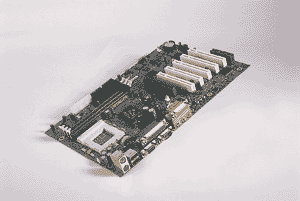 |
Intel
D815EEA
Well designed and stable
The Intel D815EEA is without doubt the flagship motherboard
from Intel as far as motherboards for the Pentium III are
concerned. The design and choice of components is by far the
most well thought of and the stability that it achieves is
something that other manufacturers can only hope to achieve.
The board also features a special retention mechanism for
the AGP card, which keeps the AGP card in perfect place.
Installation was typically easy and the BIOS detected the
CPU straight out of the box. The BIOS is very simple and easy
to get around; obviously there were no overclocking and heavy
memory tweaking options available. Another important thing
to be noticed is that the default IRQ assignments that this
motherboard gives is perfectly tuned for the right assignments.
The power management implementation was also perfect.
It is expensive, but then you get Intel's very own splash
screen on your monitor every time you boot up and since it
is based on the 815E, you get an onboard AGP. Another added
benefit is the Creative PCI 128 integrated sound.
Contact:
Ockam Infotech
Phone: 022-6212944
Price: Rs 8,600
Rating: B
|
|
| |
|
Intel
D815EPEA
Country cousin
Once again, the only difference between the D815EEA and the
D815EPEA is quite similar to the differences between the ASUS
CUSL2 and the CUSL2-C. Also, due to the absence of the onboard
accelerator and the AGP Pro slot, the price is lower.
Contact:
Ockam Infotech
Phone: 022-6212944
Price: Rs 8,000
Rating: B+
|
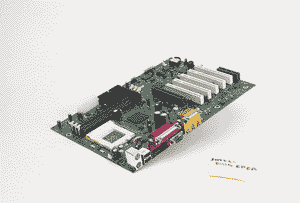 |
|
| |
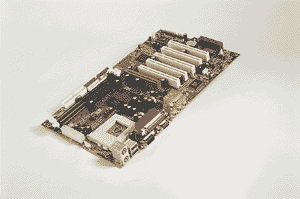 |
Jetway
618AF
Worth a look
Jetway has been around for quite some time and is known for
inexpensive but high-quality products. The board layout of
this motherboard was simple and built around the 815E chipset.
It featured all the performance and stability aspects that
you would get from other expensive boards. Though the motherboard
claims to have jumper-free process of detecting the processor
and the RAM speeds, there were still some jumpers to be set
for the 133 MHz FSB setting.
The BIOS had decent options for overclocking and the motherboard
was pretty stable when overclocked. Certain overclocking friendly
features, such as fail-safe recovery if the overclock failed,
were missing. The BIOS also failed to detect the proper RAM
timings and the RAM was detected as PC-100 instead of PC-133.
Performance as far as gaming and other applications are concerned
was pretty much the same as compared to other 815-based boards,
but surprisingly the memory benchmark scores using PC-133
RAM were a little on the lower side, though this might have
been due to the improper detection of RAM timings in the BIOS.
Considering the features that you get with this motherboard
at a lower price, coupled with decent online support, it definitely
is worth a dekko.
Contact:
Rashi Peripherals
Phone: 022-8260258
Price: Rs 6,900
Rating: B
|
|
| |
|
Mercury
KOB815eFSX
Fast, but a little unstable
Typical of Mercury, this board offers all that the other 815E
boards offer at a much lower price. While you may think that
this may affect performance, since it is still based on the
815E chipset, there's very little that can go wrong.
The board looks and feels very much like an Intel original.
The layout is excellent, something you could expect only from
other expensive boards. As it is with all 815E boards, installation
is pretty easy and can be done without any use of jumpers
or other direct user intervention. The BIOS is simple in design
and easy to use, though it lacked some overclocking options.
Strangely, the board performed a tad faster than most, but
was a little unstable. After extended periods of benchmarking,
the board would suffer a strange freeze, which it would come
out of immediately. Initially, we thought that this was something
to do with Windows, but re-installing proved that it did suffer
some stability issues when pushed to the extreme.
The board sports an AC'97 compliant onboard audio chip, but
no extra USB headers were provided. Except for the minor glitches,
which might be easily fixed with a BIOS upgrade, the board
is definitely worth a second look. The price factor and the
fact that you get almost everything that the big guns offer,
along with similar and sometimes better performance, make
it a strong contender.
Contact:
Visualan Tech
Phone: 022-8202688
Price: Rs 5,200
Rating: A
|
 |
|
| |
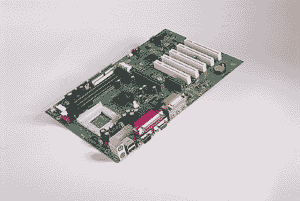 |
MSI-815Pro
Scores on design
The Indian market has been recently flooded with a whole new
bunch of manufacturers promising better quality and support.
MSI too has entered the fray and released an array of new
motherboards for the Indian consumer. The MSI 815PRO is based
on the 815 chipset that uses the older ICH architecture instead
of the now famous ICH2, the key difference being that it does
not have support for ATA-100, though this is not a major problem.
Nevertheless, the board is well designed and sports the standard
green PCB colour. With large capacitors placed slightly offset
from the CPU socket, it made installing and removing the CPU
very easy. The overall packing and accessories that came along
with this motherboard was definitely a cut above the rest.
Despite the motherboard not supporting a couple of new performance-oriented
features that ICH2 supports, the board did not suffer in any
benchmarks. More importantly, the SiSoft Sandra 2001 drive
index was pretty much what other motherboards were achieving.
The BIOS extensively supports overclocking and has a lot of
performance-oriented tweaks along with support for real-time
hardware monitoring. The board overclocked very well and the
Pentium III 800EB was easily pushed to 960 MHz (6x160), but
it did not go any higher because the motherboard does not
support frequencies above 160 MHz.
The board is relatively cheap, but remember, it does not have
ICH2 and hence lacks a few features.
Contact:
Priya
Phone: 022-2663611
Price: Rs 7,500
Rating: B
|
|
| |
|
Soltek
SL-65ME
An overclockers choice
The Soltek brand was seen in India at the recently held
IT Comdex 2000, where they drew quite some interest from the
local vendors. Subsequently, the boards have found their way
into the reseller market and are now available with relative
ease.
Soltek commands quite a reputation worldwide and is very often
the preferred choice for power users and overclockers. The
board layout is definitely up amongst the best. Whereas most
other motherboards have bunched up capacitors near the CPU
socket, this board has all the capacitors spaced out.
The BIOS was pretty detailed but had the standard looks and
design interface which everyone has become used to (blue and
red), but it did have a lot of options for memory tweaking.
Surprisingly though, the manual did not have any description
of the settings in the BIOS. Also, the manual was common for
a host of other boards with only a couple of pages dedicated
to each. So for users who would be first time buyers, it would
be really difficult to figure out which manual is for which
model.
It was in the overclocking department where the board really
started to shine. Here too the board immediately showed what
it had by displaying rock solid stability at 166 MHz (800EB@996).
Now this is no ordinary feat-with just ordinary air-cooling
the board pumped out a real mean performance. More importantly,
the frequencies could be adjusted by 1 MHz increments. The
Vcore (CPU voltage) too could be adjusted for further stability
while overclocking.
This board is definitely no pushover and it comes along with
a price tag that is simply amazing for a board of this class.
With such a proven name making headway into the market, it
definitely looks like you are going to have a lot more options.
Contact:
Rank Data Products
Phone: 022-3873168
Price: Rs 6,750
Rating: B+
|
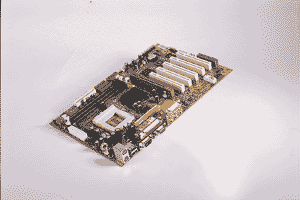 |
|
| |
i850
Tehama Chipset for Pentium 4
The Pentium 4 is based on a totally new architecture and, hence,
it requires a totally new chipset to support it. The solution
to this is the release of the i850 chipset. This chipset is
revolutionary in both design and the way it needs to be implemented.
The Pentium 4 class of motherboards are in themselves a special
breed and probably only six-eight manufacturers have the capability
to build these motherboards. This is the case because all Pentium
4 motherboards using this chipset would have a six-layer PCB
instead of a four-layer PCB that is now standard for all Pentium
III motherboards. This alone makes the entire manufacturing
process very complicated and expensive. Also, all Pentium 4
motherboards have to comply with the new ATX 2.03 power supply
standard rendering all current power supplies and cabinets totally
useless for the Pentium 4. |
|
| |
 |
ASUS
P4T
Great performance, but ahead of its time
ASUS was once again first off the block when it came to producing
a motherboard that supported the Pentium 4. The board package
comes with a special rubber base-pad along with a metal baseboard
that is built in such a way that this motherboard can fit
in any ATX cabinet. The power supply though still needs to
comply with the new ATX 2.03 specifications.
With such an early release, ASUS has not only just managed
to bring out a motherboard that supports the Pentium 4, but
has also integrated all the options and tweaks that are so
commonly available with all ASUS boards. And to prove such
commitment to performance and stability, ASUS even included
some really cool overclocking features.
Performance too was a great deal better than with the Intel
counterpart, but the price and non-availability of the new
power supplies makes this board a little ahead of its time.
Also, the aggressive 'Kit-style packaging' that Intel is following
puts other motherboards in a disadvantageous position.
Contact:
Rashi Peripherals
Phone: 022-8260258
Price: Rs 23,600
Rating: A+
|
|
| |
|
Intel
Tehama D850GB 'Garibaldi'
Unmatched component quality
The Intel D850GB is the first motherboard to come out with
support for the Pentium 4 and is based on the i850 chipset.
The motherboard is part of a kit, which includes the new ATX
2.03 compliant power supply and cabinet, 128 MB of PC-800
RDRAM and the Intel Pentium 4 1.4 GHz processor.
The board layout is very interesting and has lots of space
in and around the processor. The processor heat-sink alone
weighs a whopping 450 grams because of which the entire retention
mechanism of the processor on the board is radically different.
The board can be placed only in the newer ATX 2.03 compliant
cabinets. The board also features a second USB controller
integrated into the ICH2 supporting 24 Mbps across four ports.
The BIOS is a typical Intel BIOS featuring no tweaking or
overclocking options. Also, the RDRAM frequency tweaks are
missing. The BIOS is a little difficult to get around and
will take some time getting used to.
Since the board is the first iteration of the Pentium 4 class,
performance was a tad low. Nevertheless, the build and component
quality of Intel is unmatched. Since you will have to buy
the entire kit along with the processor, the entire package
becomes a little cheap as compared to buying components separately.
In any case, the package itself is very expensive, but if
you want the fastest available package then you have to pay
the premium.
Contact:
Ockam Infotech
Phone: 022-6212944
Price: Rs 73,000 (entire kit with 128 MB RAM and processor)
Rating: B+
|
 |
|
| |
AMD
PROCESSOR-BASED BOARDS
VIA KT-133 Chipset
The AMD bandwagon always lacked a solid platform and all efforts
were by and large short strung. But since the launch of the
VIA series of chipsets for the Socket A platform, things have
changed drastically. Not only does the new AMD processor line-up
now have an excellent platform, but VIA has finally broken the
memory bandwidth and AGP-related jinx over its chipsets. The
KT-133 chipset has almost brought in an entire new generation
of motherboards incorporating top-of-the-line features and performance.
|
|
| |
 |
ASUS
A7Pro
Little brother
The ASUS A7Pro is the strip-down version of the popular A7V,
which earlier came along with a multiplier adjustment dip-switch,
which unfortunately was discontinued later. ASUS then released
the A7Pro and its only claim to fame is the return of those
multiplier adjustment dip-switches.
The
original A7V was very expensive and feature-packed with onboard
audio and extra ATA-100 IDE headers. The board layout of the
A7Pro, on the other hand, is very sparse in that area and
features only the ATA-66 headers. For this reason alone the
price of this board is much lower and is aimed at the power
user, who would rarely use the onboard audio. Nevertheless,
the ATA-100 support will be sorely missed.
Another
thing that you notice is the riser board, which is situated
just near the CPU socket. Most motherboards have a number
of capacitors surrounding the socket and the ATX power connector.
With the A7Pro, many of these components are placed on a riser
board near the Socket A interface. With this riser board in
place, it's possible to install a wide variety of heatsinks.
The second bonus this feature adds is that installation and
removal of heatsinks is much simpler (no more bumping your
fingers against components on the motherboard) and, as a result,
CPU removal and installation becomes a breeze!
If
you are a veteran of a typical ASUS BIOS, then you won't be
surprised even a little bit. First time users, however, may
find the BIOS is a bit awkward to use, considering it has
a lot many submenus hidden underneath its five main menus.
There are a whole lot of extra settings for the VIA KT133
chipset such as the settings of the DRAM frequencies and a
whole lot of AGP settings too. For overclocking, both the
CPU core voltage and system bus speed can be adjusted through
the system BIOS.
The
board is a great buy, but it misses out on a few vital features.
Also, since the arrival of other heavy weights like Soltek,
MSI and DFI, ASUS will have to get its act together as far
as pricing is concerned.
Contact:
Zeta Technologies
Phone: 022-4102288
Price: Rs 9,950
Rating: A+
|
|
| |
 |
DFI
AK74-SC
A budget solution
First Chinese goods invaded the manufacturing sector and now
they seem to have entered the motherboard segment. DFI promises
quite a lot and claims to be amongst the top-10 motherboard
manufacturers of the world. The AK74-SC is based on the earlier
VIA Southbridge and hence does not have support for ATA-100.
The
board layout is simple and you can easily observe the cluttering
of all the capacitors around the CPU. Another odd thing that
you can notice is that instead of providing one more PCI slot,
the board designers opted for an ISA slot and this is despite
the fact that the board already has an AMR slot and onboard
sound.
The
board BIOS incorporates a lot of nifty features and you can
adjust the FSB from 100 MHz to 133 MHz in 1 MHz increments.
Surprisingly, the BIOS does not feature any CPU Vcore adjustment
options. This can prove to be quite a huge stumbling block
while overclocking and renders the FSB adjustment feature
quite useless. For the most part AMD processors are overclocked
using multiplier adjustments and once again this feature for
multiplier adjustment is missing too.
But
the board is extremely cheap and has onboard audio, making
it the ideal budget solution for the AMD processors. This
board definitely sets the stage for inducing lower pricing
for the AMD bandwagon.
Contact:
BBS Electronics
Phone: 022-8242374
Price: Rs 5,600
Rating: A
|
|
| |
|
DFI
AM35-EC
Good displays
The DFI AM35-EC uses the new KM-133 chipset from VIA. This
is the only VIA chipset for the AMD processors that has an
onboard graphics accelerator. At the same time, the motherboard
still has the conventional AGP slot for future upgrades or
for better graphic cards.
The
KM-133 series of motherboards have integrated 2D and 3D graphics
functions of the S3 Savage4 graphics chip. It utilises the
Shared Memory Architecture (SMA) to expand the display memory
and also supports an additional 4x AGP slot. You can take
advantage of the onboard display function to have a very satisfactory
display without purchasing an additional display card.
The board is available in micro-ATX form factor. Placement
of components though is cluttered and more PCI slots could
have been accommodated.
The
board features a simple and easy-to-use BIOS featuring some
really nifty features such as the Fan Guardian which alerts
the user if the CPU and the chassis fan is about to fail.
There also are some overclocker-friendly features in the BIOS,
but apart from FSB manipulation there is nothing else and
there are no voltage tweaking options. The manual is pretty
detailed and easy to understand.
With
the introduction of these boards in India, a number of choices
have come up for the AMD processor. Also, the Savage4 integrated
graphics accelerator is a much better performer than the i752,
which is onboard the 810s and the 815s.
Contact:
Zeta Technologies
Phone: 022-4102288
Price: Rs 6,450
Rating: B+
|
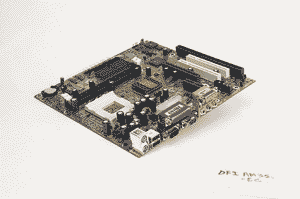 |
|
| |
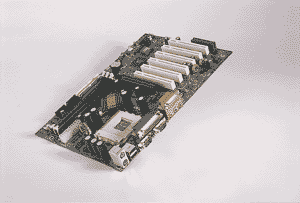 |
MSI-K7TPro2
A smart alternative
The K7TPro2 is the MSI entry for the AMD processor. Using
the KT-133 chipset, the board makes for an excellent platform
for the Thunderbird. The board layout though was a small letdown.
The DIMM slots were very close to the AGP slot, which had
a retention clip. This made it very difficult to remove the
AGP card without removing the SDRAM. This is probably the
first motherboard where the power supply connector is bang
next to the DIMM slots and that too placed in line with the
DIMM slots. It simply meant that if you wanted to work on
the motherboard then you had to remove the SDRAM first.
But
the board simply takes the cake when it comes to overclocking.
Once you have unlocked your Thunderbird or Duron, the multiplier
choices you have are mind-boggling. It is the only motherboard
that features voltage tweaks for the Vio (I/O Voltage) and
the CPU Vcore, both in the BIOS. Bus frequency overclocking
too was possible. The highest we could reach was 107 MHz,
though that is not much since Thunderbirds are not known to
bus overclock that well. The auto-detection routine of the
BIOS too worked like a charm and RAM timings were detected
perfectly in the very first boot-up. Though KT-133 has a much-improved
Northbridge, the Southbridge still has not been much refined,
hence, the board still supports only a maximum of UDMA-66.
Though the scores don't show much difference, with better
and faster drives coming out in the future with ATA-100 support,
this could prove to be a bottleneck.
Even
though AMD processors are mostly cheaper than their Intel
counterparts, platform paucity makes for expensive motherboards.
This situation is more so in India since the AMD user base
itself is pretty slim. But with excellent boards like MSI
coming out and reducing the difference in price, it provides
for some excellent alternatives to Intel.
Contact:
Priya
Phone: 022-2663611
Price: Rs 7,800
Rating: A
|
|
| |
|
Soltek
75KV2
The ultimate choice for overclockers
The Soltek 75KV2 features the newly released VIA VT82C686B
Southbridge, lending support for ATA-100 and extra USB ports.
This top-of-the-line motherboard has some real nifty features
and the one that would stun most people is the Soltek Voice
Diagnosis Technology. This feature is optional and did not
come in with this board, but the socket for the chip was present
and one can expect boards coming in very soon with this chip
onboard.
The
board layout is unique in every sense. Most motherboards have
the IDE and floppy drive headers bunched up together, but
in this case all the headers are spaced apart. Also, the ATX
power supply header is placed in an unobtrusive place. The
capacitors near the CPU too are arranged in such a way as
not to obstruct the user while installing the CPU.
This
motherboard also incorporates multiplier dip-switches onboard,
so you can change the multiplier of a normally locked CPU.
One of the most astonishing observations with this board is
that it openly promotes overclocking. There are no subtle
hints, but open instructions for multiplier unlocking and
then detailed instructions on how to set the dip-switches
for the overclock to be successful (a leaflet describing this
process is given along with the manual). But the major negative
point with these manuals is that they still use a generic
structure that contains instructions for all the other similar
boards in the same range. This makes the process of identifying
the board very difficult and can also be a potential problem
while updating the BIOS.
Soltek
also includes a rather dated software bundle that includes
Norton Ghost, Norton AntiVirus and WinFax. Nevertheless, they
are probably the first ones to do so and it comes for free
so it definitely carries some weight. Definitely a must buy
for the power user and the ultimate choice if overclocking
is your thing.
Contact:
Rank Data Products
Phone: 022-3873168
Price: Rs 6,750
Rating: A-
|
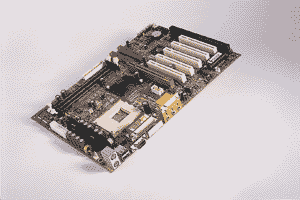 |
|
| |
|
VIA
Appolo Pro133A Chipsets
A direct fallout of the failure of the Intel 820 chipset was
the growing popularity of the VIA Appolo Pro 133s. These chipsets
captured the market when there were no motherboards that offered
full support for the 133 MHz Pentium IIIs.
The
VIA Apollo Pro133A design is based on its popular older cousin,
the Apollo Pro133. The only thing that delivered the killer
punch to the Intel chipset bandwagon was the inclusion of
a high-speed AGP 4x protocol. Also, VIA Apollo Pro133A has
a completely asynchronous memory speed interface, where the
processor and system memory bus frequencies are set independently
from each other. This architecture was first featured by the
Appolo Pro 133A and then the 815 chipset followed with a similar
architecture.
|
|
| |
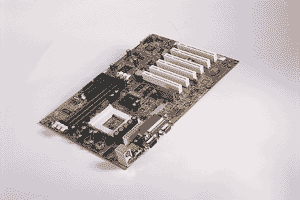 |
ASUS
CUV4X
A viable option
The ASUS CUV4X is the more refined version of the earlier
ASUS P3V4X motherboard and is based on the new VIA 694X chipset.
The board now has the standard Socket 370 format, whereas
the earlier P3V4X had the SLOT 1 architecture.
The
board layout again favours the placement of the ATX power
supply header somewhere near the AGP slot. ASUS has also properly
arranged banks of capacitors around the CPU, DIMM slots and
the power supply header.
Using
the beautifully implemented ASUS BIOS, there are options for
overclocking the FSB up to 166 MHz in small increments, coupled
with a lot of memory tweaking options.
Another
very important feature, which is actually common amongst all
ASUS motherboards, is the jumper which allows you to increase
the I/O voltage from the default 3.3 to 3.4 and a maximum
of 3.5 volts. This will increase your chances of overclocking
and improve the overall stability of the entire system, though,
as ASUS mentions, it reduces the life of the onboard components.
When
it comes to performance, ASUS has implemented Appolo Pro133A
chipset to perfection. There was a lot of debate around the
AGP implementation of this chipset, but as the benchmarks
show, they are nothing to be scoffed at. On the contrary,
the chipset provided a viable platform to the Pentium III
Coppermine when there was no proper implementation from Intel
itself.
Contact:
Mnemonic Systems
Phone: 022-8010871
Price: Rs 7,900
Rating: A
|
|
| |
|
Soltek
SL-65KV2
A
good bet
Soltek too has an Appolo Pro133A implementation featuring
the new VIA Southbridge. The SL-65KV2 is similar in design
to its ASUS counterpart. Funnily, this board too has the ATX
power supply header entrenched in a messy area filled with
capacitors and is placed near the parallel port. The CPU socket
too is a little cramped for space.
The
BIOS is the standard red and blue type and has a lot of options
for tweaking. It detected the processor and the RAM on the
first boot-up. Overclocking definitely seems to be the major
strength of Soltek, as this board too overclocked quite well.
Despite
a somewhat less than perfect AGP implementation with the VIA
chipset, the scores were very much on par with all the rest.
More importantly, it is a feature packed ATX class motherboard
that is available for less than Rs 6,000. In addition, it
also comes with a decent software bundle, which as of now
is pretty much a novelty in the Indian market.
Contact:
Rank Data Products
Phone: 022-3866308
Price: Rs 5,600
Rating: A
|
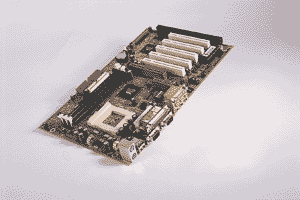 |
|
| |
MISCELLANEOUS
BOARDS
Economy boards
This category includes chipsets from other manufacturers such
as SiS and ALi. These chipsets are by and large economy solutions
and it is not possible to compare them with mainstream boards.
Chipsets made by SiS generally fall into the integrated chipset
category and are manufactured keeping the economy segment in
focus. The 630E chipset has been widely acclaimed as one of
the few chipsets from SiS to truly challenge the 810-bandwagon.
ALi has been traditionally an AMD supporter, but the one featured
here is rather unique. The ALi Alladin TNT2 chipset seen in
the ASUS CUA is by far the fastest integrated chipset solution
in terms of integrated graphics for the Intel Pentium III. Featuring
the TNT2 chipset onboard with 8 MB of dedicated memory, it is
definitely worthy of a second look. |
|
| |
|
ASUS
CUA 
A good buy, but needs improvements
The ASUS CUA is the board that ASUS touts as its gaming motherboard.
This board can truly get you gaming straight out of the box.
Though the chipset supports the shared memory architecture,
ASUS has opted for 8 MB of local dedicated memory on the motherboard.
The memory uses 64-bit architecture that can turn out to be
quite a bottleneck in 32-bit high colour gaming.
The
board BIOS features all the normal tweaks and settings you
would generally expect from ASUS. The board also features
an LCD/TV interface that can support an optional LCD/TV-out
module for LCD/TV output.
The
board though did not perform well, and this had to be attributed
to the chipset's pure memory performance. The benchmarks were
run over and over again under various RAM settings, but it
failed to register a decent memory score. The SiSoft Sandra
drive index too turned out a trifle low result, all in all
showing that the chipset has to go through further improvement
as far as memory and I/O subsystem is concerned.
Nevertheless,
the board is an excellent idea and beats all the other integrated
chipsets hands down due to the onboard TNT2.
Contact:
Mnemonic Systems
Phone: 022-8010871
Price: Rs 8,500
Rating: B
|
|
| |
|
ASUS
CUSI-FX
Small and neat
The ASUS CUSI-FX is built around the 630E chipset and uses
the flex-ATX form factor. This form factor is designed for
small sized PCs and reduces the motherboard size by as much
as 25 per cent over the micro-ATX design. The board is feature-packed
and highly integrated.
The
layout for such a small board with so many features integrated
is truly a sight to behold. Since most peripheral devices
are integrated, PCI slots are very few. There is not a single
feature that we could think that this board lacked in terms
of pure functionality. The board also had an integrated RJ-45
jack just above the USB ports. The BIOS too left no uncut
edges, though some overclocking features such as voltage tweaks
were strangely missing. But it did contain a huge list of
FSB options going up to 147 MHz.
Performance
was definitely better than the 810-class of motherboards and
these motherboards are definitely worth a look if only a stable
system is what you are looking for.
Contact:
Rashi Peripherals
Phone: 022-8260258
Price: Rs 7,800
Rating: B+
|
|
| |
|
Mercury
KOB630E FSLFX
Decent performance for less
This Mercury board features the 630E chipset and is priced
very competitively.
Mercury's
offering in this range is similar to the ASUS CUSI-FX. Sporting
the flex-ATX form factor, it has all the features that the
ASUS counterpart has to offer. The layout too is very similar
to the CUSI-FX and all components have been placed with a
lot of working space around. These smaller boards sporting
the 630E chipset are definitely a better option than the 810-based
boards. Moreover, they are cheaper than the 810 versions too.
The
board BIOS features minimal tweaks and no overclocking options,
but the fact that this board is cheaper by over Rs 2,500 compared
to its nearest competitor makes it the cheapest option for
the Coppermine processors. Performance is a little below its
ASUS counterpart, but the difference is negligible.
Contact:
Visualan Tech
Phone: 022-8202688
Price: Rs 4,300
Rating: B
|
|
| |
|
Priya
BST1B-E SiS 630E
Plain Jane
This motherboard too is designed around the 630E chipset.
Funnily enough, the board is manufactured by Procomp and resold
in India under various brands. The board uses the micro-ATX
form factor and also has a Slot 1 interface for older Slot
1 processors. This board too had jumpers with tails for easy
removal and installation. Again, for a board of this size,
the number of PCI slots were limited as also some very basic
features such as USB. It also lacked other features such as
an onboard modem.
The
BIOS was the usual 'red and blue' affair with very few options
for tweaking or, for that matter, overclocking.
Though
the motherboard is much cheaper, it is still far too behind
in terms of basic features offered. However, the 630E chipset
beats the 810 in gaming benchmarks and the memory bandwidth
offered by these chipsets as seen in the benchmarks is better
than what 810 offers. So, if you are looking for a plain Jane
motherboard, then you could take a second look at this one.
Contact:
Priya
Phone: 022-2663611
Price: Rs 3,825
Rating: B-
|
|
| |
BX
chipset
The BX chipset has been around for almost two years now and it has
started to finally show signs of old age. With Intel stopping production
of the BX chipset, availability of motherboards based on this legendary
chipset has become scarce. There are still some manufacturers who
have refined motherboards around this chipset to perfection. |
| |
 |
ASUS
CUBX-E
Ageing legend
ASUS has probably released the maximum number of motherboards
based on the BX chipset. It has refined, tweaked and added
features to make motherboards based on this chipset still
viable. CUBX-L is one such example; it has so much to offer
that it simply is the best possible BX-based motherboard you
can buy.
The
board is slightly wider than other boards because of the fact
that ASUS offers support for as many as eight IDE devices
using the ATA-100 controller that replaces the CMD-based controller
that was on the earlier CUBX and had support for only ATA-66.
All the four IDE connectors are placed one after the other,
which makes it a little messy while inserting the IDE cables.
As
with all ASUS boards, the BIOS has all the necessary overclocking
features-using the Pentium III 700E, it easily overclocked
to 933 MHz and was quite stable.
Despite
the fact that the 440BX chipset cannot theoretically support
bus speeds of more than 100 MHz, CUBX supports frequencies
up to150 MHz, which makes installing the 133 MHz-based processors
possible but risky. This is because of the AGP multiplier,
which is probably the only flaw in the BX platform, making
bus speeds for the AGP run out of specification when running
at 133 MHz.
But the fact remains that despite being feature packed and
a proven record for stability, it has little or no future
in terms of flexibility for the next generation of processors.
Contact:
Mnemonic Systems
Phone: 022-8010871
Price: Rs 7,900
Rating: B+
|
|
| |
|
|
Skip
Ahead :
1 Introduction
2 Test Process
3 Product Reviews
4 Comparison Table |
| |
| |
| Help
|
Feedback
| Credits
| FinePrint
| QuickLinks |
|























